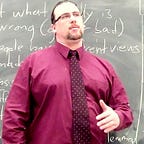Classic Metal Class Session 9 — The Sunset Strip and the L.A. Connection
a massive heavy metal scene explodes in Los Angeles during the 1980s!
We devoted a number of the early episodes of Classic Metal Class to music history coupled with some philosophical analysis, covering these main topics:
- Early Heavy Metal (1970–1974)
- The Black Sabbath — Deep Purple Nexus
- Mid-Late 1970s Heavy Metal In The British Scene
- The New Wave of British Heavy Metal (NWOBHM)
- American Metal in the 1970s
You notice that this was pretty Brit-heavy, just shifting attention explicitly to the USA in the last session. For number nine, we wanted to follow up on that American emphasis, and we settled on the West coast, and specifically the L.A. heavy metal scene, which definitely has its roots in the mid-late-1970s, but which simply explodes in the early 1980s. You could view what was going on there — in Los Angeles and the surrounding parts of California — as something analogous to the New Wave of Heavy Metal movement in Great Britain.
Musical scenes rarely develop in a vacuum, of course, and the L.A. metal scene was no exception. Major British metal bands and musicians were already spending a significant portion of their time there in the 1970s, particularly though not exclusively along what was called the Sunset Strip. Black Sabbath, Motorhead, and Def Leppard are just a few that come to mind. There were also quite a few European musicians who flocked to L.A. , like the Finnish band Hanoi Rocks, the Dutch band Vanderberg, and the Swede Yngwie Malmsteen (who played in Steeler and Alcatraz, before going solo)
American metal musicians from the East coast, like Gene Simmons and Ronnie James Dio (along with his wife, Wendy) were also getting involved in identifying, networking, producing, and promoting West coast talent. There was also a good bit of “poaching” local talent going on, one prime example of which is Ozzy Osbourne’s band incorporating Randy Rhoads and Rudy Sarzo from Quiet Riot, followed by Jake E. Lee from Rough Cutt.
Here’s the videorecording from the session, if you’d like to watch it:
One influential theorist and scholar focusing on heavy metal who we often reference is Donna Weinstein, whose book Heavy Metal: The Music And Its Culture (a revision of her earlier Heavy Metal: A Cultural Sociology) remains a classic study of the music, movement, history, and community. She argues that before metal spiraled off into a vast host of genres, we can distinguish three main developing currents to the overarching genre:
- traditional heavy metal — the mainstream of the movement from the early 1970s onward
- lite or glam metal — a softening of the sound shifting it in a more pop and radio-friendly direction
- speed or thrash metal — a shift towards faster, heavier, more extreme sound
The Los Angeles scene of course includes all three of these early genres of heavy metal, and there are quite a few bands that straddle these categories. Ratt provides a prime example. They definitely can be called part of the “glam” movement and scene, but there always remains a hard edge to their music, a heaviness and grittiness to their sound, that doesn’t place them solely into the “traditional” category, but extends them into portions of that space.
Since we plan to devote an entire session to the thrash movement, we decided not to focus on those bands, as important as they are. Instead, we chose to look at L.A. bands who fit into those other two categories. These aren’t the only bands we discussed, of course, but Scott and I put our heads together to come up with a representative list of 10 key L.A. heavy metal bands:
- Van Halen
- Motley Crue
- Ratt
- Dokken
- Quiet Riot
- WASP
- Poison
- Lizzy Borden
- Armored Saint
- Cirith Ungol
We covered a lot of ground in our conversation, looking at how L.A. turned into a mecca for heavy metal for the better part of a decade. We looked at the bands that were fairly short-lived, but which were part of a vital ferment that brought newer bands and their musicians into prominence, gaining them audiences and record deals. Mickey Ratt would eventually morph into Ratt. Sister and Circus Circus would lead to Wasp. Rough Cutt musicians would go on to Ozzy, Quiet Riot, and Dio.
There’s a lot more to say about the Los Angeles metal scene in the 1980s, but we did that in the session, so I’ll leave off here, and let you just watch or listen to the conversation!
I’m Greg Sadler, the Heavy Metal Philosopher. You can join me and my co-host Scott Tarulli each month for a new session of Classic Metal Class).
I’m also the president of ReasonIO, a speaker, writer, and a producer of highly popular YouTube videos on classic and contemporary philosophy. I teach at Milwaukee Institute of Art and Design, and offer classes to the wider public in my Study With Sadler online academy. I also produce the Sadler’s Lectures podcast and co-host the Wisdom for Life radio show
